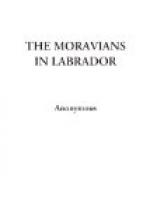INTRODUCTION.
The Moravian Mission in Labrador was attempted under circumstances scarcely less discouraging than those under which the brethren were enabled to achieve the moral conquest of Greenland, was attended with incidents still more romantic, and blest with a success equally remarkable. But it possesses a peculiar interest to British readers, having been commenced under the auspices of the British government, and promising a more extensive influence among tribes with whom British intercourse is likely to produce a wider and more intimate connection.
The Peninsula of Labrador extends from the 50th to the 61st deg. N.L. It is somewhat of a triangular form; bounded on the north by Hudson’s Straits, and indented by Ungava Bay; on the east by the northern ocean; on the south by Canada and the Gulph of St Lawrence; and on the west by Hudson’s and James’ Bay, which last coast, by a kind of anomaly in nomenclature, has been called the East Main, from its situation to that great inland sea.
The German geographers do not appear to doubt, what some of our own have called in question, that the discovery and the name of this Peninsula, at least of its eastern shores, were owing to the Portuguese, Gaspar Cortereal, who, in the years 1500 and 1501, in an expedition fitted by the king to discover a western passage to India, reached the coast of Newfoundland about the 50th deg. N.L., and sailed northward to nearly the entrance into Hudson’s Bay. This tract of country was originally called after its discoverer, Terra Cortereali, a name since superseded by that of Terra de Labrador—the land capable of cultivation. Davis Straits, here about one hundred miles broad, separates it from Greenland, whose southernmost point, Cape Farewell, lies in the same degree of latitude, [60 N.L.] with Cape Chudleigh, the northernmost extremity of Labrador. The Straits of Bellisle run between it and Newfoundland. The land along the shore is abrupt and precipitous, indented with many little creeks and vallies, surrounded by innumerable islands, and rendered extremely dangerous of access from the multitude of sunken rocks. The interior is mountainous, intersected by marshes, and abounding with streamlets and lakes.
Detached from the Arctic lands, this country ought to partake in some degree of the temperate cold regions, but whether owing to the elevation of its mountains, or the influence of the perpetual fogs that cover the neighbouring seas, it is as frozen a region as those to the west of Hudson’s Bay; and though it lies some degrees farther south than Greenland, yet the cold during the long winter is far more severe, the thermometer being frequently 32 deg. below 0 deg. of Fahrenheit. Perhaps the immense quantity of drift ice which accumulates on the eastern shores, and which extends for so many miles out to sea, may have some influence on the temperature of the climate. The summer, on the other hand, during the short time




